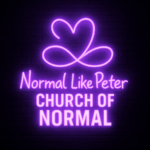
Complex PTSD (CPTSD) is not a character flaw.
It is not weakness.
It is not “too much.”
CPTSD is what happens when a nervous system adapts to prolonged emotional threat, especially in environments where escape, repair, or safety were inconsistent or unavailable.
At Normal Like Peter, we talk about CPTSD as a patterned survival response, not an identity and not a diagnosis.
CPTSD is a framework used to understand how long-term stress and relational trauma shape:
emotional regulation
attachment and bonding
threat perception
memory and time awareness
self-concept under stress
These responses were protective once.
They only become painful when the environment changes but the nervous system hasn’t caught up yet.
People with CPTSD may experience:
Hypervigilance or constant scanning for danger
Emotional flooding or sudden shutdown
Strong reactions to perceived abandonment or rejection
Difficulty trusting repair to last
Shame spirals that appear “out of nowhere”
Feeling older than their age — or frozen at a younger one
These are patterns under stress, not personality traits.
CPTSD is often misunderstood because its outward expressions can resemble other clinical labels.
At Normal Like Peter, we are explicit:
We describe patterns, not personalities.
Under stress, many humans temporarily display traits that get mislabeled as disorders.
That does not mean the person is that disorder.
This site does not diagnose anyone — including you.
Most CPTSD wounds were formed in relationship, not isolation.
That’s why CPTSD often activates most strongly in:
romantic bonds
family systems
authority dynamics
spiritual or community spaces
The nervous system learned its rules there.
It also relearns safety there — slowly, with consistency.
CPTSD recovery is not about becoming tougher, quieter, or more agreeable.
It is about:
teaching the nervous system what now is
restoring accurate threat detection
building tolerance for calm
learning repair instead of collapse
Progress often looks boring from the outside — fewer spikes, shorter loops, quicker recovery.
That’s healing.
We use:
narrative reflection (Captain’s Logs)
pattern language instead of diagnoses
humor and satire as pressure-release valves
theology without shame
systems thinking instead of blame
This is education and storytelling, not therapy.
If you are working with a licensed professional, our content may help you name what you’re already noticing — nothing more.
This page exists to help people understand themselves, not to label others.
Please do not use CPTSD language from this site to:
diagnose a partner, ex, or parent
win arguments
justify staying in harm or causing harm
rally others against someone
If you’re unsure what’s real, bring your experiences — not labels — to a qualified professional.
That doesn’t mean something is “wrong” with you.
It usually means:
your nervous system learned early
you adapted well
and now you’re noticing the cost
Awareness is not collapse.
It’s the beginning of choice.
Normal Like Peter and Church of NORMAL publish trauma-informed educational and creative content.
Nothing on this site is medical, mental-health, legal, or crisis advice.
If you are in immediate danger or emotional crisis, seek local emergency services.
In the U.S., you can call or text 988.

CPTSD and Borderline Personality Disorder (BPD) are often confused — not because they are the same, but because nervous systems under chronic relational stress can look similar from the outside.
This section exists to reduce harm, not to sort people into boxes.
Under threat or abandonment stress, both CPTSD and BPD frameworks may describe patterns such as:
intense fear of abandonment
emotional swings that feel sudden or overwhelming
strong attachment bonds formed quickly
difficulty trusting stability to last
shame, self-blame, or identity confusion under stress
rapid shifts between closeness and withdrawal
These are state-based nervous system responses, not proof of a fixed identity.
Mislabeling usually occurs when:
Context is removed
Observers see behavior but not history, triggers, or power dynamics.
Stress states are mistaken for traits
What appears “constant” is often situational and relational.
Diagnosis becomes shorthand for pain
Labels get used to explain confusion, not to support healing.
Relational trauma is collapsed into character judgment
Especially in breakups, family conflict, or online commentary.
This is why we say:
Traits under stress are not identity.
While this site does not diagnose, a common educational distinction used in trauma-informed spaces is this:
CPTSD frameworks emphasize adaptation to prolonged threat
BPD frameworks emphasize patterns of emotional regulation and identity under relational instability
But in real life, these frameworks often overlap, especially when:
trauma was relational
attachment wounds were repeated
safety was inconsistent
repair was unpredictable
Overlap does not equal equivalence — and it does not equal permanence.
When people misuse labels:
partners stop seeing each other as human
accountability turns into pathology
complexity gets flattened into blame
healing becomes harder, not easier
This site actively resists that harm.
We do not allow CPTSD or BPD language to be used here as:
a weapon,
a verdict,
or a substitute for boundaries.
Not
“What’s wrong with this person?”
But
“What pattern is activating here — and why?”
Patterns can be interrupted.
Identities do not need to be attacked.
Resonance with overlap descriptions does not mean:
you are broken
you are dangerous
you are doomed to repeat cycles
It usually means:
your nervous system learned quickly
you bonded deeply
and repair mattered a lot
Those are survival skills — even if they now need updating.
Please do not use this section to:
diagnose someone in your life,
“prove” an ex was disordered,
justify harm or avoidance,
or rally others against a person.
If clarity is needed, take experiences and patterns, not labels, to a licensed professional.
Because silence creates stigma.
And stigma creates misuse.
Education — done carefully — reduces harm.